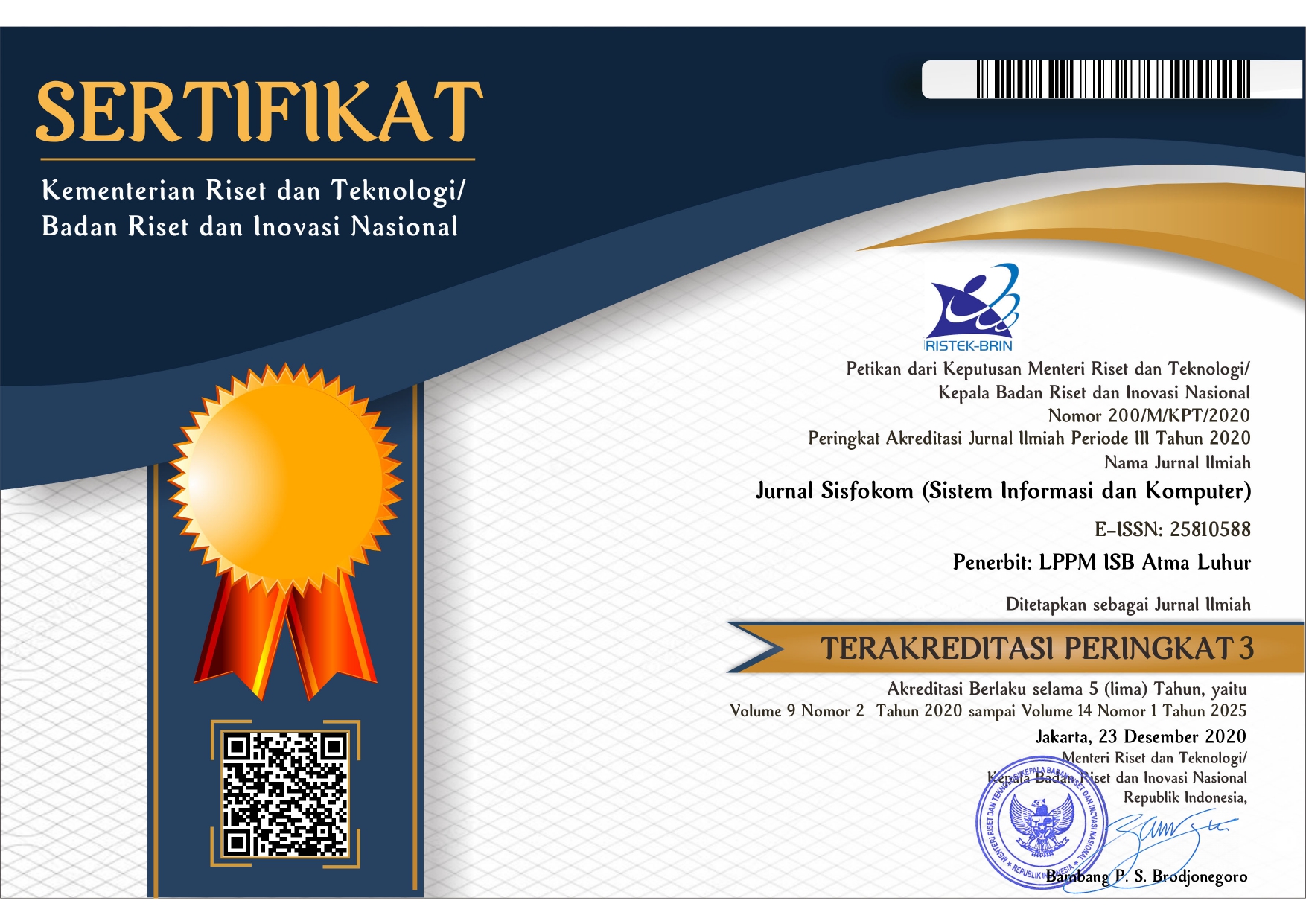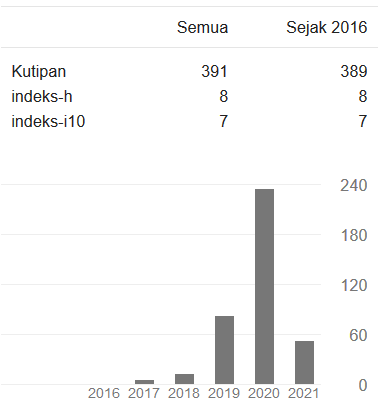Unveiling Public Sentiment on Quarter Life Crisis: A Comparative Performance Evaluation of Support Vector Machine and Naïve Bayes Algorithms on Social Media X Data
DOI:
https://doi.org/10.32736/sisfokom.v14i3.2405Keywords:
Quarter Life Crisis, Sentiment Analysis, Support Vector Machine, Naïve Bayes, Social MediaAbstract
Quarter Life Crisis (QLC) is one of the psychological issues experienced by many young adults and is characterized by uncertainty, anxiety, and emotional distress. In the digital era, public opinion about QLC is increasingly expressed through social media, particularly platform X. This study seeks to classify public opinion related to the QLC into positive and negative sentiments by employing two computational classification models, namely Support Vector Machine (SVM) and Naïve Bayes (NB). Despite the growing discourse, there has been no study specifically comparing classification algorithms to analyze public sentiment on QLC. Data collection was conducted through crawling techniques on platform X from November 2024 to January 2025, resulting in a total of 1120 tweets. The data underwent preprocessing, lexicon-based sentiment labeling, and TF-IDF word weighting. After preprocessing, classification using SVM and NB was evaluated by accuracy, precision, recall, and F1-score. Results indicate that SVM achieved superior performance with an accuracy of 83%, outperforming NB, which recorded 74%. These outcomes demonstrate that the SVM algorithm demonstrates superior performance in analyzing public sentiment regarding QLC. This research contributes by providing empirical evidence regarding algorithm performance for sentiment analysis in mental health topics, offering recommendations for effective early detection strategies utilizing social media data.References
P. R. Pamungkas and G. Hendrastomo, “Quarter life crisis di kalangan mahasiswa,” Saskara: Indonesian Journal of Society Studies, vol. 4, no. 1, pp. 174–188, 2024.
Karpika I Puti and Segel Ni Wayan Widiyani, “Quarter Life Crisis Terhadap Mahasiswa Studi Kasus di Fakultas Keguruan dan Ilmu Pendidikan Universitas PGRI Mahadewa Indonesia,” Widyadari, vol. 22, no. 2, pp. 513–527, 2021, doi: 10.5281/zenodo.5550458.
M. Naufal and E. Yassar, “Konsep Diri dan Quarter Life Crisis pada Mahasiswa Magister Self Concept and Quarter Life Crisis on Master Students,” vol. 22, pp. 93–104.
S. M. Agustina, P. N. Fitriani, and H. C. Haryanto, “STUDI DESKRIPTIF QUARTERLIFE CRISIS PADA FASE EMERGING ADULTHOOD DI KOTA MATARAM SAAT MASA PANDEMI,” INQUIRY: Jurnal Ilmiah Psikologi, vol. 13, no. 01, Aug. 2022, doi: 10.51353/inquiry.v13i01.639.
Kukuh Wijayanti and Qoniah Nur Wijayani, “Peranan Aplikasi Twitter Atau X Dalam Interaksi Komunikasi Guna Membantu Penyeimbangan Kesehatan Mental Pada Remaja Saat Ini,” Journal Sains Student Research, vol. 2, no. 1, pp. 07–15, 2023, doi: 10.61722/jssr.v2i1.469.
L. Nursinggah, R. Ruuhwan, and T. Mufizar, “Analisis Sentimen Pengguna Aplikasi X Terhadap Program Makan Siang Gratis Dengan Metode Naïve Bayes Classifier,” Jurnal Informatika dan Teknik Elektro Terapan, vol. 12, no. 3, 2024, doi: 10.23960/jitet.v12i3.4336.
M. A. Amrustian, W. Widayat, and A. M. Wirawan, “Analisis Sentimen Evaluasi Terhadap Pengajaran Dosen di Perguruan Tinggi Menggunakan Metode LSTM,” JURNAL MEDIA INFORMATIKA BUDIDARMA, vol. 6, no. 1, p. 535, Jan. 2022, doi: 10.30865/mib.v6i1.3527.
Muhammad Daffa Al Fahreza, Ardytha Luthfiarta, Muhammad Rafid, and Michael Indrawan, “Analisis Sentimen: Pengaruh Jam Kerja Terhadap Kesehatan Mental Generasi Z,” Journal of Applied Computer Science and Technology, vol. 5, no. 1, pp. 16–25, 2024, doi: 10.52158/jacost.v5i1.715.
P. Syahputra and R. Kurniawan, “Analisis Sentimen Terhadap Kesehatan Mental Remaja Menggunakan Metode Naive Bayes,” Journal of Information System …, vol. 5, no. 4, pp. 1216–1224, 2024, doi: 10.47065/josh.v5i4.5644.
F. Darmawan, M. Joe, Y. I. Kurniawan, and L. Afuan, “Analisis Sentimen Kemungkinan Depresi dan Kecemasan pada Twitter Menggunakan Support Vector Machine,” Jurnal Eksplora Informatika, vol. 13, no. 1, pp. 24–36, 2023, doi: 10.30864/eksplora.v13i1.854.
N. A. Haqimi and T. A. Roshinta, “Analisis Komentar Spam Instagram menggunakan Support Vector Machine dengan Variasi Hyperparameter,” vol. 9, no. 3, pp. 242–253, 2024, doi: 10.30591/jpit.v9i3.7834.
M. A. Saddam, E. Kurniawan D, and I. Indra, “Analisis Sentimen Fenomena PHK Massal Menggunakan Naive Bayes dan Support Vector Machine,” Jurnal Informatika: Jurnal Pengembangan IT, vol. 8, no. 3, pp. 226–233, 2023, doi: 10.30591/jpit.v8i3.4884.
F. Koto and G. Y. Rahmaningtyas, “Inset lexicon: Evaluation of a word list for Indonesian sentiment analysis in microblogs,” in 2017 International Conference on Asian Language Processing (IALP), IEEE, Dec. 2017, pp. 391–394. doi: 10.1109/IALP.2017.8300625.
O. I. Gifari, Muh. Adha, F. Freddy, and F. F. S. Durrand, “Analisis Sentimen Review Film Menggunakan TF-IDF dan Support Vector Machine,” Journal of Information Technology, vol. 2, no. 1, pp. 36–40, 2022, doi: 10.46229/jifotech.v2i1.330.
E. Dani and N. Setiani, “PERANCANGAN UI/UX SISTEM INFORMASI VALIDASI SERTIFIKAT KOMPETENSI BERBASIS DIGITAL,” JIPI (Jurnal Ilmiah Penelitian dan Pembelajaran Informatika), vol. 10, no. 1, pp. 163–177, Jan. 2025, doi: 10.29100/jipi.v10i1.5758.
F. D. Adhiatma and A. Qoiriah, “Penerapan Metode TF-IDF dan Deep Neural Network untuk Analisa Sentimen pada Data Ulasan Hotel,” Journal of Informatics and Computer Science (JINACS), vol. xx, pp. 183–193, 2022, doi: 10.26740/jinacs.v4n02.p183-193.
P. D. R. Maulidiana, A. V. Vitianingsih, S. Kacung, A. L. Maukar, and D. Hermansyah, “Comparative Analysis of SVM and NB Algorithms in Evaluating Public Sentiment on Supreme Court Rulings,” Jurnal Sisfokom (Sistem Informasi dan Komputer), vol. 13, no. 2, pp. 230–236, 2024, doi: 10.32736/sisfokom.v13i2.2116.
Dania Siregar, Faroh Ladayya, Naufal Zhafran Albaqi, and Bintang Mahesa Wardana, “Penerapan Metode Support Vector Machines (SVM) dan Metode Naïve Bayes Classifier (NBC) dalam Analisis Sentimen Publik terhadap Konsep Child-free di Media Sosial Twitter,” Jurnal Statistika dan Aplikasinya, vol. 7, no. 1, pp. 93–104, 2023, doi: 10.21009/jsa.07109.
E. Martantoh and N. Yanih, “Implementasi Metode Naïve Bayes Untuk Klasifikasi Karakteristik Kepribadiaan Siswa Di Sekolah MTS Darussa’adah Menggunakan Php Mysql,” Jurnal Teknologi Sistem Informasi, vol. 3, no. 2, pp. 166–175, 2022, doi: 10.35957/jtsi.v3i2.2896.
M. Fachriza and Munawar, “Analisis Sentimen Kalimat Depresi Pada Pengguna Twitter Dengan Naive Bayes, Support Vector Machine, Random Forest,” Jurnal Teknik Universitas Muhammadiyah Ponorogo, pp. 49–58, 2023, [Online]. Available: http://studentjournal.umpo.ac.id/index.php/komputek
W. D. Yuniarti, A. N. Faiz, and B. Setiawan, “Identifikasi Potensi Keberhasilan Studi Menggunakan Naïve Bayes Classifier,” Walisongo Journal of Information Technology, vol. 2, no. 1, p. 1, 2020, doi: 10.21580/wjit.2020.2.1.5204.
I. Siti Aisah, B. Irawan, and T. Suprapti, “Algoritma Support Vector Machine (Svm) Untuk Analisis Sentimen Ulasan Aplikasi Al Qur’an Digital,” JATI (Jurnal Mahasiswa Teknik Informatika), vol. 7, no. 6, pp. 3759–3765, 2024, doi: 10.36040/jati.v7i6.8263.
Downloads
Published
Issue
Section
License
Copyright (c) 2025 Talitha Dwi Septyorini, Khothibul Umam, Maya Rini Handayani

This work is licensed under a Creative Commons Attribution 4.0 International License.
The copyright of the article that accepted for publication shall be assigned to Jurnal Sisfokom (Sistem Informasi dan Komputer) and LPPM ISB Atma Luhur as the publisher of the journal. Copyright includes the right to reproduce and deliver the article in all form and media, including reprints, photographs, microfilms, and any other similar reproductions, as well as translations.
Jurnal Sisfokom (Sistem Informasi dan Komputer), LPPM ISB Atma Luhur, and the Editors make every effort to ensure that no wrong or misleading data, opinions or statements be published in the journal. In any way, the contents of the articles and advertisements published in Jurnal Sisfokom (Sistem Informasi dan Komputer) are the sole and exclusive responsibility of their respective authors.
Jurnal Sisfokom (Sistem Informasi dan Komputer) has full publishing rights to the published articles. Authors are allowed to distribute articles that have been published by sharing the link or DOI of the article. Authors are allowed to use their articles for legal purposes deemed necessary without the written permission of the journal with the initial publication notification from the Jurnal Sisfokom (Sistem Informasi dan Komputer).
The Copyright Transfer Form can be downloaded [Copyright Transfer Form Jurnal Sisfokom (Sistem Informasi dan Komputer).
This agreement is to be signed by at least one of the authors who have obtained the assent of the co-author(s). After submission of this agreement signed by the corresponding author, changes of authorship or in the order of the authors listed will not be accepted. The copyright form should be signed originally, and send it to the Editorial in the form of scanned document to sisfokom@atmaluhur.ac.id.









